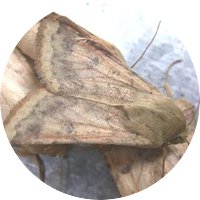
The lights are on — but are the moths home?
Research co-authored by CFANS entomologist Bill Hutchison suggests the fuzzy nocturnal flyers are becoming less attracted to light over time

Corn earworm moths these days seem to be avoiding the limelight. For decades, the nondescript late-night insects (Helicoverpa zea) flew to light traps like, well, moths to a flame. In more recent years, scientists have noticed a dwindling cast of the small, beige-ish characters under the bright stage lights, leading some to believe that the numbers of moths (and other insects) are declining.

This is serious because while H. zea is in general a pest to crops, insect populations around the world appear to be in rapid decline, with potentially disastrous consequences for the ecosystems they inhabit. Moths are, after all, nighttime pollinators and an important food for animals like bats.
Conservationists around the world are working hard to protect the most ecologically important and/or at-risk insect species. And while fewer bugs basking in the brightness doesn’t necessarily mean they aren’t out there in large numbers, it's critical for scientists to find other ways to monitor data to accurately align historical estimates from light traps.
Research published in the Journal of Insect Conservation, co-authored by University of Minnesota College of Food, Agricultural and Natural Resource Sciences entomology professor and Extension specialist Bill Hutchison, indicates that entomological light traps may be catching fewer insects today than historically due to increases in human-caused light pollution.
Blacklight trap data collected in Delaware over 25 years and in Minnesota for 16 years, mirrored with 10 years of monitoring in New Jersey, shows a precipitous decline in H. zea populations. However, pheromone trap data (traps baited with blends of synthetic female sex pheromones that attract reproductive males of a particular species) indicates that H. zea populations have remained relatively stable.
“If the difference between blacklight and pheromone trap catches at the same location has changed over time, all else being equal, this would strongly suggest that one or both trap types have become better or worse at sampling the local insect population,” said Hutchison. “Importantly, this finding would not significantly alter our broader understanding of insect declines.”
What does it mean, then, for census takers of the insect world? According to Hutchison, it’s all the more critical that entomologists identify more dependable ways to measure the volume of bugs, and to modify their expectations when looking at historical data — so we can see what’s really happening in the dark.





